2018 has been a year of firsts for me. I finally passed my driving test (sadly not on the first attempt), I travelled to South America for the first time and had my first experience eating guinea pig. Yes, you read that correctly. That cute fluffy pet that we keep in the UK and the US, I ate him.
For all of the vegetarians that have just clicked the back button on their browser and all the meat-eaters crying ‘savage’ from behind their computers, allow me to explain a little bit about the history behind eating guinea pig and why eating guinea pig could just save the planet!
Header photo by Nestor Lacle under CC by 2.0 Flickr.com.
Read more: (opens in new tab)
When Did People Start Eating Guinea Pig?
For many of us living in the UK and US, guinea pigs don’t get our mouths watering. In fact, they probably bring up childhood memories of our first fluffy family addition. However, it was only once the South Americans began to bring guinea pigs into Europe that they first became pets. Whilst there is evidence to suggest Europeans have never commonly eaten guinea pig, that is not the case in South America.
It is not a recent development that has seen guinea pigs end up on the plates of humans. In fact, archaeologists believe that guinea pigs were first considered as a food source in 5,000BC! Bolivia, Colombia, Ecuador and Peru are all countries which have seen these furry little rodents grace local plates for thousands of years.
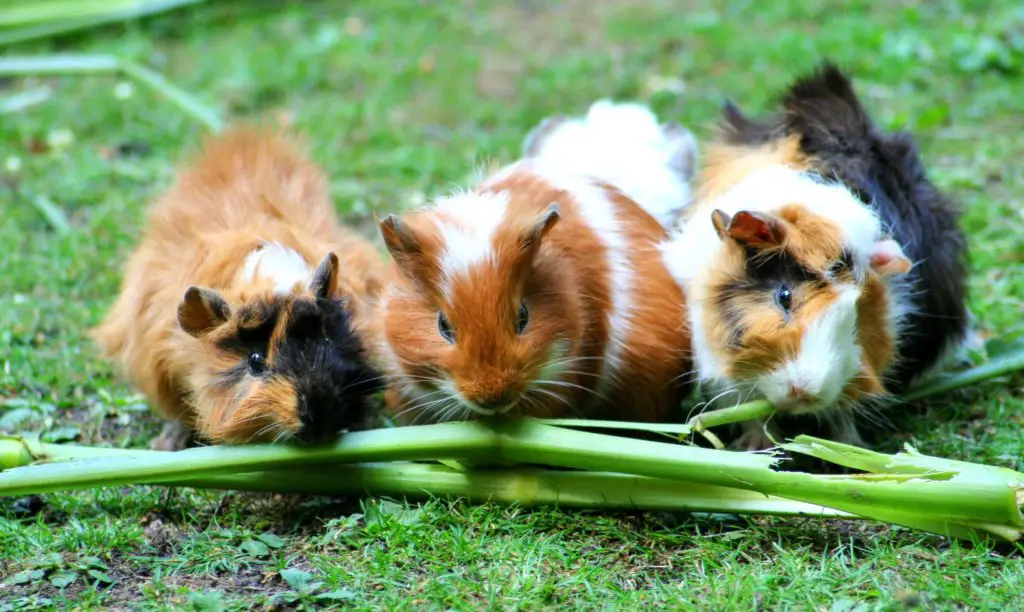
Across South America today, guinea pigs are known to the locals as Cuy. This is the Kichwa translation which comes from the high-pitched sound that the guinea pigs make. Not going to lie, thinking about that as you’re pondering your menu choice isn’t helpful.
Where Should I Eat Guinea Pig?
Whilst cooked guinea pig can be found all over Ecuador and Peru, there are certain places which are recommended more than others. I have been told by locals to avoid the rainforest regions and instead try Cuy in the Andes mountain range. As this is where guinea pigs were first eaten, it is believed that they tend to be cooked to a higher standard in these areas. Tim and I decided to put Cuy in our Ecuador itinerary and try it in the city of Cuenca. For more strange foods you can try in Ecuador, check out this post on jungle town Misahuallí!
It is definitely worth doing your research when it comes to finding a place to eat Cuy. I have heard and read a number of reports from people who say it tastes amazing and plenty from those who say it is chewy and fatty. The consensus seems to be that no matter your opinion on eating guinea pig from a moral point of view, the quality of the cooking tends to be make or break when it comes to enjoyment.
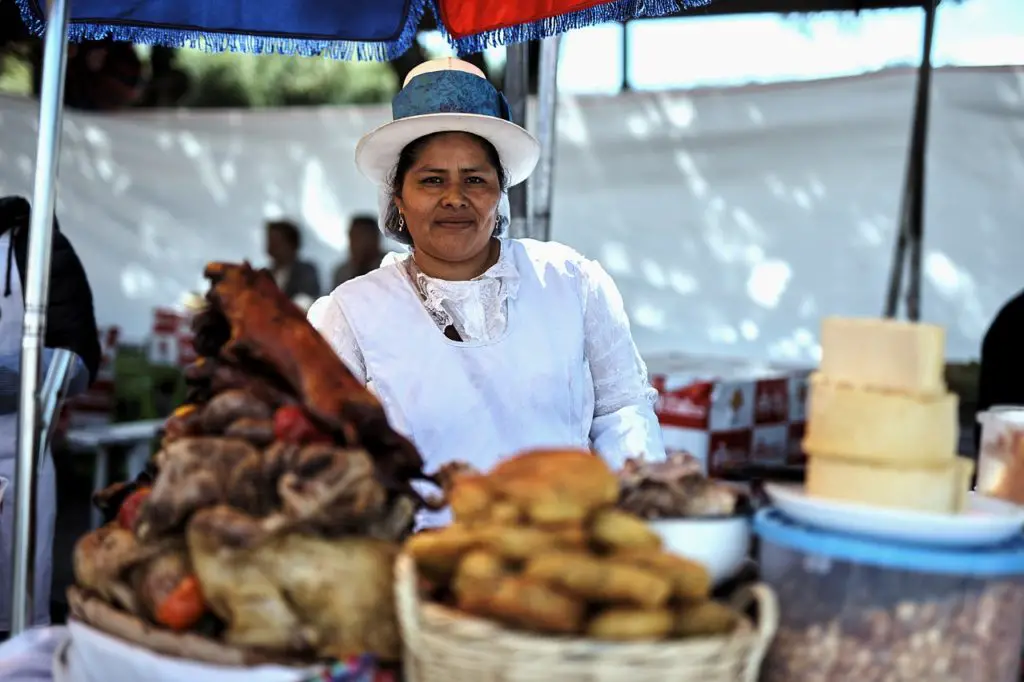
From a personal point of view, I would definitely recommend Cuenca’s restaurant ‘Tres Estrellas’ in which to try guinea pig. One portion of Cuy is good to share between two people and also comes served with potatoes, beans and corn. The average price of a guinea pig between two people in Ecuador is around $25. Whilst this is pricey in comparison to most local dishes, it is generally only eaten on special occasions and is considered to be a delicacy in these areas.
How is it Cooked?
There are a couple of ways to cook guinea pig, generally either roasted, baked or fried. The Cuy that Tim and I ate in Cuenca was roasted on a spit (you are recommended to book at least an hour in advance to give it time to cook) and then fried off. Like with pork in Ecuador, the animal is sometimes blow-torched prior to cooking to remove the hair.
What Does Guinea Pig Taste Like?
Having always appreciated how cute guinea pigs are, I wondered how I would cope with trying to eat one. Whilst I am much more open-minded about my diet now, I will confess I don’t like eating things with a face. I know that’s ridiculous but sometimes it still turns my stomach.
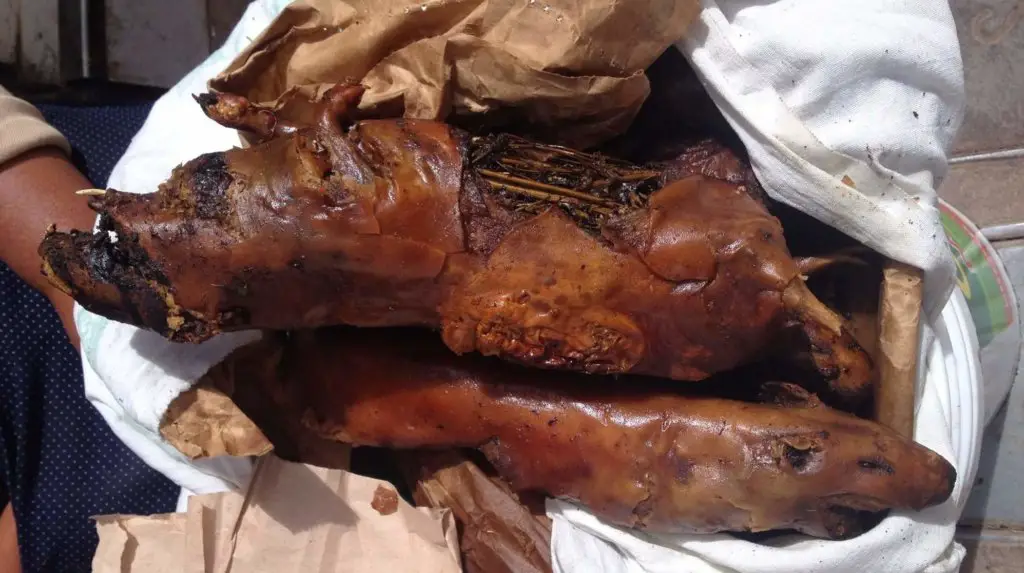
The guinea pig arrived pre-cut into sections but complete with all of its limbs and head. Surprisingly, after smelling the meal heading towards us, I was no longer concerned about whether I would be able to stomach the delicacy. I tucked straight in.
I have heard people say that the meat of the guinea pig tastes similar to chicken but I think this is a cliched simplification of its taste. Gamey in texture, it is more similar to that of rabbit but with an extremely crispy exterior. The skin is extra salty and is fried to the point where it cracks as you cut it. I would say it is most similar to a good pork crackling.
The Environmental Impact of Eating Guinea Pig
With all of the current focus on preserving the environment, some activists are trying to market guinea pigs as a carbon-friendly beef alternative. The rearing of cattle produces a huge amount of greenhouse gasses, owing to the methane emitted by the cows when they release wind. We all know that such gasses are bad for the environment which could lead us to conclude that guinea pig farms are a more environmentally friendly alternative.
As we have seen from looking at the history of eating guinea pig, these little critters have been eaten for generations. They are docile, which makes them much easier to farm then larger animals. Not to mention, you can actually raise hundreds of guinea pigs in an area as small as your back garden. That is definitely less land than the average cow requires!
Owing to their size, cows require a huge amount of food to sustain them and allow them to grow to the size required for the meat market. As you would expect, guinea pigs require much less food which makes them more cost-effective to raise.
Cattle require masses of land which has had a huge environmental impact. There is nowhere suffering from the consequences of deforestation as much as the South American countries. The desire to maintain and protect the Amazon Rainforest is heavily impacted by the need for farming space, which has resulted in crazy levels of deforestation. Widespread consumption of guinea pig would certainly be one way to offset this damage.
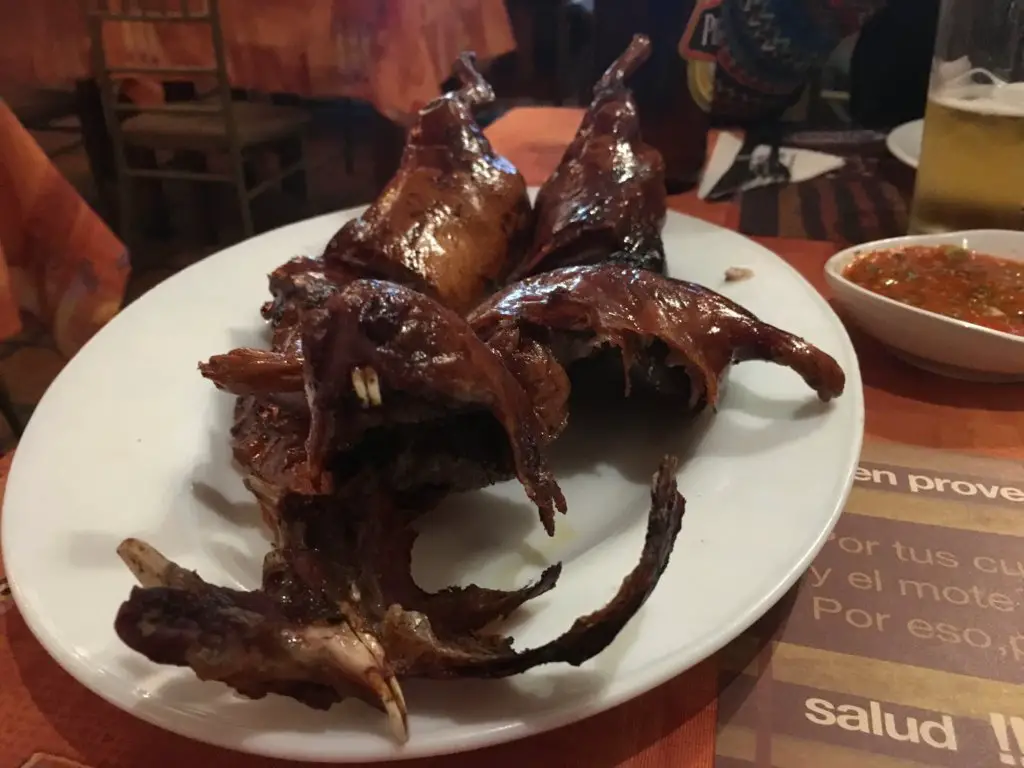
Is Eating Guinea Pig Morally Wrong?
This depends on your perspective. Of course, there are vegetarians are screaming in horror after seeing the photos of fried up rodents on this page. Whilst I am not veggie, I can see their point. At least they’re consistent in their non-meat consumption.
As for all the meat-eaters out there, I struggle a little with their outrage. In the West, it would be fair to say we are all very removed from what ends up on our plate. Very few of us feel comfortable eating something cuddly and even less of us feel comfortable watching our food be killed. Surely though, as a meat-eater that is ridiculous? The fact is that if you eat meat, you should accept that it comes from an animal. Pick your side: either all animals matter or none do.
Whilst guinea pigs aren’t the meatiest animal you could choose to eat, there are a number of benefits to picking this dish over other kinds of meat. Cuy is high in protein and lower in cholesterol making it arguably a healthier choice than many other types of meat.
Eating Guinea Pig: The Verdict!
I know that it isn’t going to be for everyone but I believe that there are only benefits to be had by putting guinea pig on the menu. Not only is the meat very good for you health-wise but there are also huge environmental benefits to farming guinea pig over cattle. We are currently doing such immeasurable harm to our planet in the name of feeding ourselves which we could easily reduce through lifestyle changes. It seems to me that through eating guinea pig we may not only reduce our carbon footprint but also become a little more open-minded about our neighbours as well.
Would you eat guinea pig?
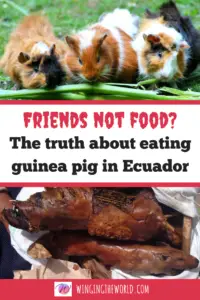
Love it? Pin it! 🙂

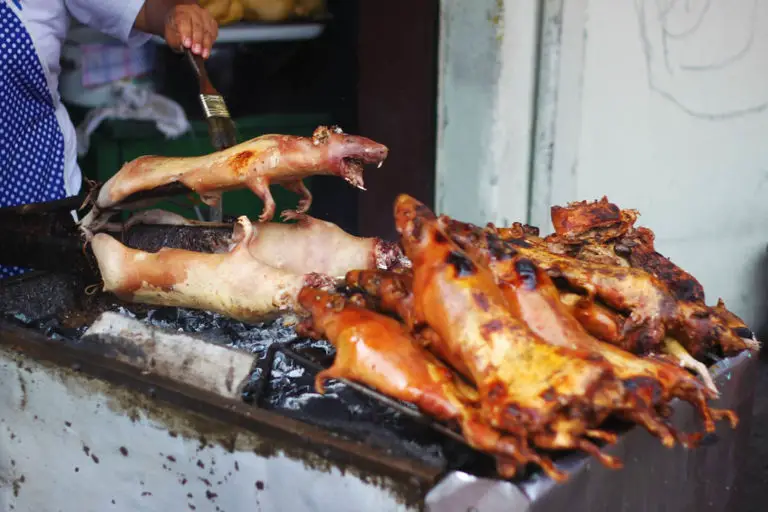
I came upon this just now, for which thank you. As I am carnivore, eating only meat, animal products and animal fat, I have no qualms about what meat I eat as long as it tastes good.
I am fortunate enough to live in an area in which venison is available at a small fraction of the price of more conventional cuts and I avail of it when run out of meat to eat.
My wife and I have raised and slaughtered rabbits and chickens, so we are not squeamish and will try anything at least once – ever eaten crocodile? We have and prepared right it is not bad at all.
This winter we managed to get a 35kg warthog, which we cut up and packed into the freezer. Most venison is rendered palatable by soaking it in a brine consisting of 1 tablespoon of salt to each litre of water. Leave for 12 hours at first and then adjust according to you taste. V let the warthog for thirty six hours, as we were told it has a very gamey taste. She cooked some last night and it is delicious!
We have never eaten guinea pig, but will not hesitate to try if it is offered. My motto is “if it lies on my plate long enough for me to stab it with a fork, I’ll eat it.”
I envy you your ability to travel the world. The best we have ever done is this: https://jumpshare.com/v/ittYvQWPE9Kg9FCStsUQ?b=QiHas2GLri1UyPaeVVFH
We love the outdoors and train our dogs to explore the wild places with us, off-leash, as can be seen here: https://jumpshare.com/b/GniZ2SuBmyixVVwxzqII
Just by the by: I have a younger sister named Sheree, second name Kim.
Good luck and enjoy your adventures.
I am a vegetarian, and personally, i would rather people ate guinea pigs then cows. They take up less space and people can produce their own meat. People might appreciate eating meat more if they had to raise and slaughter the animal themselves.
Great post. I am the type of guy who would try anything as long as it looks good and I must admit they do look good.
I am currently installing a run in my garden to raise guinea pigs for our table (Norfolk, UK). The only meat we eat at present is wild game, and we want our own source of eco-friendly meat. This is the way forward for our planet! I do worry about what people will think when they find out. We will have to feed them cuy and convert them!
Next up is a pheasant breeding project.
I am actually based in Norfolk too – how funny! I completely agree that sustainable meat sources are the future and raising your own is probably the best way to go. It always amazes me how many people are willing to eat meat but won’t acknowledge the process which has to happen for the food to reach our plates. Good luck with both projects! 🙂
Hello, I have just come across your post on winging the world where you mentioned in 2020 that you were going to be raising Guinea pigs for you own source of meat. Do you also sell Guinea pig meat?
I don’t know if guinea pigs eat less food than cattle. You need to consider the yield of how many pounds of meat per pound of food fed to the animal.
A 750 pound steer can forage on grass alone if needed. I am not sure sending guinea pigs out to pasture would be as simple.
Then there is the consideration of rodents in mass numbers developing diseases. Who knows.
Yield of meat per pound of food consumed is higher for guinea pigs than cattle. Almost double I believe. So definitely more planet friendly.
I’ve given up beef in my diet. My red meat consumption consists of deer, elk, and antelope. Much healthier…and elk is tastier I think.
Why not just eat beans, potatoes, rice, and the abundance of fruits and vegetables that Exuador grows. Leave animals off your plates. What’s so hard about that!
Yes, I agree!
Guinea pigs may require less space than cattle; however to humanely raise them as a food source (if there is such a thing) they actually need more space than what people realize. They also require a much more diverse meal plan to be healthy than what most people realize. The amount of breeding required to produce enough meat per person per meal is substantial if we are discussing replacing guinea pigs with cows. For example one cow feeds approximately 2300 people. I am not arguing that cows need to stay the main source because I do realize that the overconsumption is problematic in regard to health and environmental impact. I admit my bias, as I am a Guinea Pig owner and vegetarian. My ideas about the ethics and morality aside, in researching some of the points made in this blog I found them to be highly flawed, which is not surprising considering the lack of sources sighted and research included. I can’t understand the concept of killing a whole being for one meal that is probably going to leave you hungry in 20 minutes, but to each their own I guess…
I see all of the comparisons between raising cattle and raising Guinea pigs but why not compare something similar in size like chickens or squab to raising Guinea pigs? I’d rather raise chickens and have eggs AND chicken to consume, or goats. It’s funny to jump right in to comparing the greenness of raising Guinea pigs to cattle…just for the greater shock effect I assume.
Last time I checked, goats and guinea pigs are not the same size… 😉
The point of comparing guinea pigs to cattle is because the latter has the biggest carbon footprint out of all meat.
Regardless of food to meat ratios, guinea pigs can be raised inside your home. Food can be cultivated outside in small spaces. They reach maturity around the same time as chickens. They have a higher protein and lower cholesterol level than beef or chicken, and actually have omega 3’s. It’s incredibly hard to raise chickens in small backyards because they are prone to diseases, and need to be moved around like cattle in order to maintain health.
Guinea pigs can be raised with exercise equipment and stairs to make up for lack of room. They typically weigh about as much as a normal chicken (when not injected with steroids). Plus, less cleanup, less noise, and less everything. Let’s be honest. Our current way of living is a dizzy spell. sure we can live off of the garbage we eat today, but in reality, meat is needed. Good luck harvesting wheat, oats, and legumes out in the wild when our economy collapses. It just isn’t realistic.
At one point all we’ll have resources for are two things, meat and veg. Everything else is consequential of commercialization. Egypt found that out more than once. Africa is a direct result of massive over-cultivation. It dried up water sources, and led to the vast deserts in northern Africa.